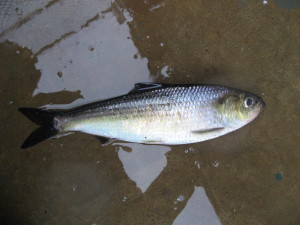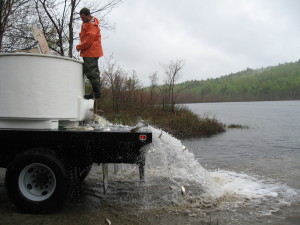by Dana Little May 2007
In late summer, schools of alewives swarm by the shore; all moving in the same direction, thousands upon thousands of silvery fish about 2 inches in length. You can see them from afar, their silvery sides reflecting the sunlight. The water appears to boil with them. Pickerel and bass thrust into their midst, creating sudden swirls of water. Kingfishers dive-bomb them from above; loons and mergansers swim to feed upon them. Alewives grow to adulthood in the ocean far away but come home to Taylor Pond to breed.
Alewife caught at Brunswick Dam Fish Ladder.
Mike Brown of the Maine Department of Marine Resources has stocked Alewives in Taylor Pond since 1999. This stocking program brings in about three-thousand fish into our pond every year. In the spring, usually starting after the first week in May, the adult alewives head up the AndroscogginRiver from the ocean towards Taylor Pond. They recognize the distinctive “scent” of Taylor Pond in the water pouring out of MerrymeetingBay at PophamBeach. They swim all the way up to the Brunswick Dam which stops them. The Department or Marine Resources catches them at the Brunswick fish ladder and trucks them up to Taylor Pond. Adult alewives are nearly a foot in length and over a half-pound in weight. Mike unloads the fish into the pond to provide what he considers its carrying capacity of approximately 6 fish per acre.
Dumping Alewives into Hooper Pond
The adult fish remain in the pond 3-4 weeks, laying eggs and feeding. The adult fish return by way of Taylor Brook down to the AndroscogginRiver and back to the ocean. The young hatch from the eggs and grow up to be the silvery fish that we see late in the summer. They feed on the zooplankton (microscopic animals) that grow abundantly during the summer. Mike samples the larval fish as they migrate down Taylor Brook during the summer and fall when they return to the ocean. He will come 40-50 times during the summer to measure Taylor Pond’s production of alewives. Mike considers Taylor Pond to be good habitat due to its shallow water, warm temperature and the small size of the pond.
Once the young fish return to the ocean, they feed and grow rapidly for the next 3-4 years. Scientists call fish that live most of their lives in the ocean but that return to fresh water to breed anadromous. Alewives share this trait with brown trout, Atlantic salmon and the American eel. Locally, scientists consider the alewives to be the most abundant anadromous fish. Historically, Native Americans and early European settlers highly valued them for food. A variety of animals prey upon alewives including our resident bass, pickerel and pike. In the ocean a variety of commercially harvested fish depend upon alewives as food. In the 1970’s annual harvests of alewives in Maine exceeded 3 million pounds, more recently fisherman have harvested less than a million pounds. Harvested alewives currently serve primarily as bait fish for lobster traps. On our pond a variety of birds including loons, mergansers, kingfishers and herons enjoy the fish. Otter and mink also can be seen feeding on fish.
The alewives’ highly developed olfactory sense, their sense of “smell”, tells them which river has Taylor Pond water mingled with it. Thus each spring they choose to travel up the Androscoggin to return to Taylor Pond. Someday we hope that these fish will once again be able to complete the entire journey independently. For now, we depend on the Department of Marine Resources to maintain the population of this fantastic fish. And the Department depends upon us to keep Taylor Pond a prime habitat for the fish.

